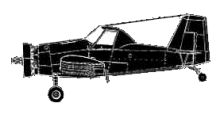
ASN Wikibase Occurrence # 284736
This information is added by users of ASN. Neither ASN nor the Flight Safety Foundation are responsible for the completeness or correctness of this information.
If you feel this information is incomplete or incorrect, you can submit corrected information.
| Date: | Wednesday 20 June 2007 |
| Time: | 07:00 LT |
| Type: |  Air Tractor AT-301 |
| Owner/operator: | West Central Aerial Sprayers Inc |
| Registration: | N23667 |
| MSN: | 301-0410 |
| Year of manufacture: | 1981 |
| Total airframe hrs: | 5981 hours |
| Engine model: | Pratt & Whitney R-1340 |
| Fatalities: | Fatalities: 0 / Occupants: 1 |
| Aircraft damage: | Substantial |
| Category: | Accident |
| Location: | Fergus Falls, Minnesota -
 United States of America United States of America
|
| Phase: | Unknown |
| Nature: | Agricultural |
| Departure airport: | Fergus Falls Airport, MN (FFM/KFFM) |
| Investigating agency: | NTSB |
| Confidence Rating: |
The agricultural spray airplane sustained substantial damage during a forced landing following a severe engine vibration during cruise flight. The pilot reported that he was in cruise flight about 500 feet above ground level (agl) when the engine and airframe started to vibrate violently, and the windshield became covered with oil. He made a forced landing to a field, but the main landing gear broke off and the airplane flipped over. Inspection of the airplane revealed that one of the propeller blades was missing about 9 inches of the propeller blade tip. The propeller blade was cut and the piece with the fracture surface was sent to the National Transportation Safety Board's Materials Laboratory for examination. The inspection of the fracture surface revealed that the propeller bladed failed as a result of a fatigue crack, with features typical of impact of a rotating propeller blade with a foreign object. Aircraft maintenance records indicated that the propeller blade was repaired and overhauled on October 21, 2003. The overhaul documents indicated that the no discrepancies were found when the propeller blades and hub underwent visual and non-destructive testing. The aircraft operator reported that he had purchased the propeller blade from another operator as a "0" time blade since major overhaul. Since installing the propeller on the accident airplane, it had been flown for about 30 hours. The operator reported that the accident airplane did not have a propeller strike during the 30 hours of operation prior to the accident flight.
Probable Cause: The propeller blade failure during climb due to a fatigue crack. The oil leak that obstructed the pilot's vision was a factor in the accident.
Accident investigation:
 |
|
Sources:
NTSB CHI07LA173
Revision history:
| Date/time | Contributor | Updates |
|---|---|---|
| 01-Oct-2022 06:50 | ASN Update Bot | Added |
Corrections or additions? ... Edit this accident description
The Aviation Safety Network is an exclusive service provided by:


 ©2024 Flight Safety Foundation
©2024 Flight Safety Foundation